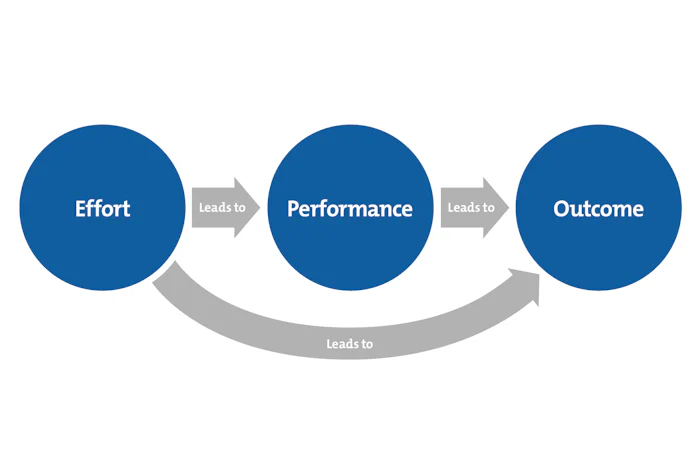Access the essential membership for Modern Managers
What drives you to go the extra mile to bring in a project on time? Or to deliver the highest-quality customer service?
Chances are, it's the belief that you'll be rewarded for your effort. The harder you work, the higher your performance level, and the greater your reward.
This simple chain of perceived cause and effect is the basis of Expectancy Theory. It advocates creating and maintaining strong links between high effort, high performance, and proper reward.
In this article, we'll explore how you can put the theory into practice, to motivate your team.
What Is Expectancy Theory?
Victor Vroom, business school professor at the Yale School of Management, introduced Expectancy Theory in 1964, in his book "Work and Motivation." More recent studies indicate that it remains one of the most comprehensive explanations of motivation.
Expectancy Theory argues that the strength of our motivation to act in a particular way depends on the strength of three expectations:
- That making more effort will improve performance.
- That a high level of performance will bring a reward.
- That the outcome – your reward – will be attractive.
So, as a manager, you need to create and demonstrate the reality of two links: first, between high effort and high performance; and second, between high performance and a positive outcome. These automatically create a third link – between high effort and a positive outcome – and so help to motivate your people. These links are shown in Figure 1, below:
Figure 1 – The Expectancy Model

Adapted from "Work and Motivation." © John Wiley & Sons, Inc. Used with permission.
Note:
How exactly you implement Expectancy Theory will vary depending on your workplace's culture, as highlighted by this study. This is because, at its core, the theory is a framework that tries to explain the thinking behind people's motivation. It's not a series of defined steps to follow.
How to Link Effort and Performance
First, team members need to know that they're putting their time and energy into the right things. So, make sure that they know what counts.
Share your company's vision and values, agree clear goals that will help to deliver organizational objectives, and set regular review and measurement points.
Ask yourself these questions:
- What is the definition of "doing well"?
- What quality or quantity of work do you require, by when?
- How do people need to behave with one another?
- What personal traits would you like them to develop?
Note:
Be sure not to set unrealistic or unfair goals: you want to motivate your people, after all, not to demoralize them. Make sure that the goals, though stretching, are likely achievable.
Next, your team will need the right knowledge, skills and resources to turn its effort into high performance. So, support a learning culture, enable cross training and collaboration, foster initiative, and provide appropriate project- and time-management systems.
Expectancy Theory is based on an assumption that people can choose how to behave. Build on this by coaching and encouraging your team members. This will help them to believe that they can control the factors that determine success.
How to Link Performance and Outcome
Rewards don't have to be financial. Positive outcomes for your people might include great working relationships, opportunities for development, more autonomy, or simply a satisfying match between the job and an individual's skills.
Make sure that roles are designed so that you can apply Expectancy Theory. For example, when you're setting goals for each team member, be sure to talk to each person as an individual to find out what motivates (or demotivates) him or her, and associate achievement of those goals with a specified reward.
Use these questions to help you to think carefully about each reward:
- Does the person value the reward you offer? Is it something he wants?
- How can you make the reward more valuable to him?
- What other reward can you offer that has higher value to him?
Note:
According to psychologist Frederick Herzberg, the presence of "hygiene" factors can cause significant job dissatisfaction even when motivating factors are present – so be sure to find these out too!
Managing Expectations
Sometimes, despite your best efforts to establish the links that are central to Expectancy Theory, circumstances beyond your control can get in the way of team motivation.
For example, you might not have the resources to provide the rewards that people want. Or, there might be a shortage of suitably skilled people in the market, so your existing team members risk overload.
In these situations, be sure to recognize everyone's hard work, to explain the lack of success, and to revise your strategy for the future.
On the other hand, if performance becomes mediocre through lack of effort, give prompt and effective feedback that shows how both performance and outcome can improve.
Warning:
Take care to avoid demoralizing your team through excessive or unfair criticism.
Key Points
Expectancy Theory is a comprehensive and well-respected explanation of motivation. It highlights the idea of linking effort and performance to reward.
For the theory to be useful, your team must understand what counts as high performance, be equipped to deliver it, and value the rewards on offer.
The theory is concerned with individual expectations, so beware assuming that people have the beliefs, knowledge, tools and confidence to do a good job – and be sure to spend time finding out!



